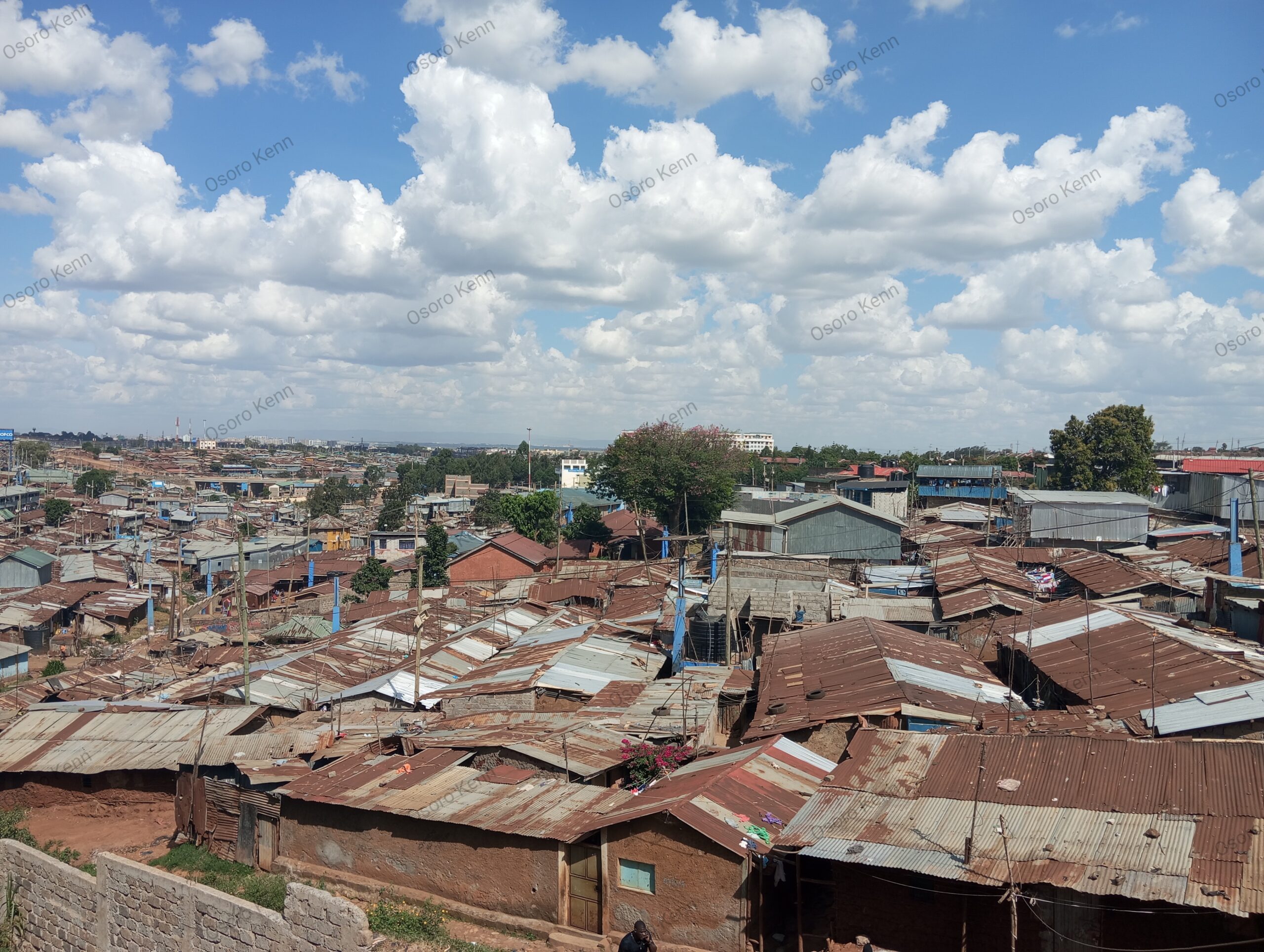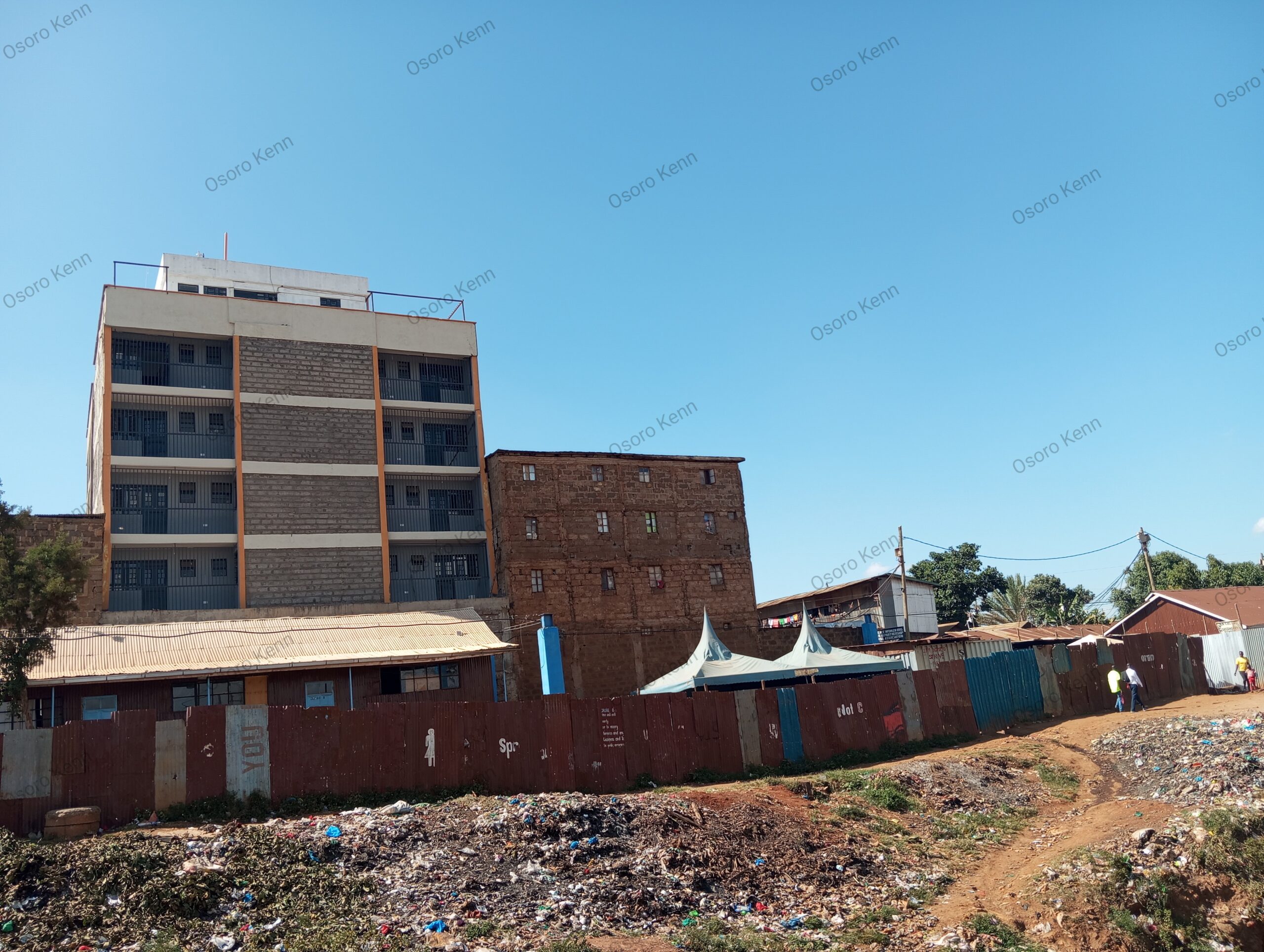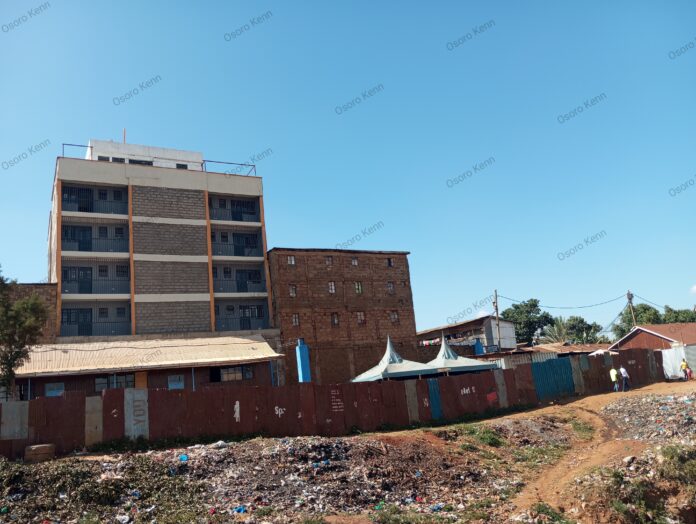By Ken Osoro
Nairobi, Kenya: Tension has escalated over the relocation strategies used during the actualization of a section of Kibra land dubbed ‘288 Acres.’ This is due to the move by the state to roll out the implementation of affordable housing to bridge the housing deficit which has generated heated debate.
The majority of residents have allayed fears that they might soon be rendered homeless in the likely event informal settlement eradication will be actualized in the area mentioned above.
Relocation concerns establish that Kibra is no longer a residential area but a vested interest area. An enviable space where everyone wants to have a share.
“Residents are living in absolute fear, tension has escalated,” these were the first statements uttered by Fredrick Ojiro, Rapid Response Officer at Haki Afrika amid comic relief.

A source seeking anonymity also explained a trend taking shape in the recent evictions in eradicating slums to estate stature.
The incognito cries fault that the beneficiaries of these houses are never the previous inhabitants.
“There is a new trend everywhere house upgrading is taking place, the beneficiaries are strangers. Invaders take advantage. The initial squatters don’t get any second chance. That is what is bringing much tension” the source reiterated.
3 Types of Land Ownership in Kenya
In Kenya, land is classified under private, public, and community land. Private land is owned by an individual under freehold or leasehold tenure while public land is vested in the government for the benefit of the people in Kenya.
Community land is held by and managed by communities. It includes land registered under group representatives, grazing areas, and ancestral lands.
The leasehold of 288 acres prompted the appointment of a 39-member task force chaired by Ahmed Yakub (community representative) assisted by two deputies namely Said Athman (Quantity Surveyor) and George Arwa (Surveyor).
The task force which comprised community representatives, quantity surveyors, representatives from the housing and lands ministry, representatives from the attorney general’s office, legal experts, and land administrators, showed a clear lack of trust among themselves.
A member of the task force detailed to the public in a community radio station on December 2023 during sensitization that the relationship of task force members had always been skeptical and uncertain.
The nine-month tenure of the working group was met by constant miscommunication and wrangles between different parties for what the source revealed rocketed as time ebbed along. This was a result of suspicions and trust in the diversified committee.
“Initially there was a problem among trustees, this sparked a lot of debate, and there was constant miscommunication and wrangles. This was as a result of trust issues,” as revealed by Ismail Abdala Ali, Land CEO of Kibra Nubian Community Land Trust (KNCLT) and a member of the Task Force and Secretary of the workgroup.
The majority of the residents whom we engaged know that the 288-acre land is freehold. This to them, means they will not pay any land rates.
288-Acre Land is Freehold
Freehold tenure gives the owner absolute rights to do anything they want with the land, subject to laws and regulations. However, under leasehold tenure, the land owner is a tenant of the government and has to pay yearly rates to the government.
“288 acres of land is a leasehold. Land rates must be paid. The lease period is 99 years and we will be paying land rates annually,” Suleiman Aganas, Chairperson of the KNCLT explained.
Article 40 of the constitution grants everyone the right to own land in any part of the country. However, if anyone is not a Kenyan citizen, they are limited to only owning land by leasehold for 99 years.
“A land that is leased has to be paid. We have to sensitize the community that this land is leased and therefore lease rates (land rates) payment is indisputable,” Aganas added.
A section of squatters who seemed well versed with the law around adverse possession of land argued that legal battles might also arise during relocation.
Some of them have occupied small portions of land and even built rental houses but no party has complained to them that they are the registered owner of the occupied portions.
A legal concept within the confines of the law denotes that if a person occupies and uses a piece of land that is registered to another person without interference from the real owner for twelve years or more, then the real owner is barred by law from claiming the piece of land.
The constitution of Kenya is deprived of an article that deals with evictees, as such, there are international treaties that the courts have always considered. This includes the right to adequate housing which requires anyone to refrain from forced evictions.
Other international treaties that courts have rallied on include the International Covenant on Civil and Political Rights (ICCPR) and the African Charter on Human and People’s Rights (ACHPR) which seeks to protect fundamental rights of persons.
It states that where there is unlawful occupation, an opportunity for genuine consultation and adequate notice must be granted.
After completion of said upgrading, individuals living within 288 will be subjected to pay land rates.
However, in as much as people are keen on living in a decent and well-established environment, not everyone is in for the idea of paying annual or monthly land rates. The two parties (task force and area residents) are pulling towards the opposite direction.
A section of Nubians are claiming they are legally settled and vowed not to engage in any land rate subscriptions imposed on them. The chairperson of the KNCLT committee on his part insisted that payments of land rates will be mandatory.
In the committee’s defense, this money will cater for the bank’s upfront payment for keeping- 288 Acre- title deed in the bank.
On a further probe, we established that the title deed bank rates have not been paid from the date it was issued and deposited in the bank.
The leadership of the KNCLT was at the time this story was being published on a move to beseech the county government to intervene and plead with the bank to lessen the already accumulated amount.
“The leadership is yet to discuss with the county government of Nairobi to collectively coax the bank to waive the rates. The amount is 8 million every year.” Aganas detailed their plea.
Despite the government’s effort to lift the bank rates, this did not have any impact, the relevant body was still far from paying title deed bank rates. Was the interest accumulating and to what extent had it accumulated? That is a development the team will follow up on.
Political Undertone From the Local Leaders
Local leaders have kept mum on the best implementation strategy. A prominent figure was even reluctant to address the issue. He said every person has his/her ancestral home.
Fredrick Ojiro, Rapid Response Officer at Haki Africa on his part, noted that land tussle has been a simmering and emotive issue in Kibra since the inception of the upgrading plan.
“There are few elites not living in Kibra, taking advantage of the middle class, most of whom are tasked to do advocacy in sensitizing the community, but in a real sense, they have their vested interests.”
On further interrogation, he poised there is so much tension and politics surrounding the upgrading project.
“Have a look at some of the slum upgrading projects. The new squatters are not the initial inhabitants. This is the only tension that is building up,” He exclaimed.
Ojiro faulted local leaders for registering a loud silence, adding they would be defending and fighting for those who might be permanently affected during relocation or resettlement.
In as much as we might agree majority of those living in Kibra have their ancestral land; just as the leader who sought anonymity alluded, shades are thrown at the non-Nubians who do not know their ancestral home.
The Plight of Street Children
This category includes street children. What is their plight, where will they go? Will they not fight for their space before being relocated?
Well, a report by the International Needs United Kingdom (I.N.U.K) dated September 2023, noted that the majority of the children living on the streets in Nairobi live in informal settlements of Kibra, Kawangware, and Eastlands.
From the findings, approximately 300,000 children and young people are estimated to be living on the streets in Kenya. Of these, about 60,000 live in Nairobi.
A report by Assistant Chief Sarang’ombe Ward, Nehemiah Omwocha, indicated that residents will not be unlawfully displaced.
The board of trustees tabled a master plan and explained to the local administration how they would cater to the rights of every individual. This did not, however, come out clearly from further explanation.
“This is a project that aims at upgrading a section of the slum inhabited by the Nubian community, the famous 288 Acres that the government had earlier issued its title deed,”
The Assistant Chief agreed with the fact that tension has escalated and there are undertone murmurs. According to him, there should be more engagement and public participation to see through a successful implementation of the project.
“Tension and chances of inter-tribal conflict are looming if proper sensitization and public participation will not be re-conducted.”
He said the project would not only elevate a section of the slum to an estate stature but also create employment opportunities for the youths, and urged residents to be vigilant, exercise constraints, and desist from inflammatory, inciting, and provocative language.
Article 24 (5) on the limitation of rights and fundamentals states that limitation to the enjoyment of the Bill of Rights must be reasonable to avoid a situation where the constitution gives in one hand and takes away with the other.
The developmental process should therefore be within the confines of the Constitution and Universal Declaration of Human Rights.
The data captured in the last economic survey report, May 2023, by the Kenya National Bureau of Statistics noted increased land and environmental cases in five years.
Filed cases rose by 593 from 5834 cases in 2018. There has been a consistent upward trajectory since 2020 in the number of land cases filed.
A downward trend was however noted in the number of pending cases in 2022. These cases ultimately decreased by 9%.
There was a marked increase in the number of cases disposed of from 5748 to 8284 in 2022. This was an increase of 44%. The increase was attributed to the transfer of cases from one court to another.
The judiciary increased the number of land and environmental judges to cushion the backlog of pending cases in the corridors of justice, and as such, the distribution of judges increased in 2021 and 2022.
The dispensation of environmental and land judges increased by 54% in 2021 to a total of 51 judges. The number of judges deployed was however constant in 2022.
There has also been an upward trajectory in the number of land and environmental female judges distributed in the past five years.
Topographical Nature of Disputed 288-Acre Land
The then 4100 Acre which was scaled down to 288 Acre according to the office of the KNCLT has 13 villages.
These are Salama now Karanja, Toi, Kambi Lendu, Kambi Aluru, Makina, Makongeni, Kambi Muru, Lindi, Mashimoni, Laini Shabaa, Lang’ata, Soweto and Ayany or Lomle.
Aganas said these names are the identities of the Nubian community. As time ebbs along, they are keen on retaining their tradition and culture.
In August 2012 the government gazetted the famous 288, sources however revealed that it took nine months before having a sight at the title deed. The deed was later handed over after five years, in 2017, owing to insecurity challenges and trust-related issues.
Copies seen maps the ‘288 Acre Nubian village’ by landmarks. It covers the DC area- Nairobi Dam marked by a small river stream- to the far end opposite stream from Karanja along Kibra Drive from DC to Toi market stage- Kibra Primary- Stara Primary school, along the railway line to Nairobi Dam in Shilanga.
“Geographically, this area (resembles a shoe) includes Toi, Makina, Kambi Lendu, Kambi Muru, Kambi Aluru, Lindi and Shilanga,” noted Aganas.
How Does This Task Force Work
A gazette notice No 1415 dated February 6 by the then Land, Public Works, Housing and Urban Development CS Zachariah Njeru opined key objective of the task force was to assess and propose practical strategies for the redevelopment and construction of affordable housing.
This land was allocated to the Kibra Nubian Community on the 2nd of June 2017.
It followed the constitution of minor committees such as the Village Liaison Committee (VLC), Community Executive Liaison Team (CELT), Grievance Redress Panel (GRP), and Kibra Nubian Community Land Trust (KNCLT)- custodian of the title deed.
The Grievance Redress Panel, which had no working office at the time this story was published, was mandated to solve grievances. The community channeled their complaints to this seven-member committee.
Faiza Mwami, Secretary GRP explained the committee was accepting grievances from both Nubian and Non-Nubian through email.
The 2019 census shows that a small number of Kibra residents have access to smartphones. This poses an ultimate concern for individuals who can access email addresses. Using an email address’s bare minimum is tantamount to having either a laptop, tablet, or smartphone.
This was an inference for the residents to conclude that this activity was meant for the ‘have’ and not the ‘have not.’
Faiza on her part defended the use of email addresses claiming that summoning ‘Barazas’ and seminars every time is tiring area residents amid busy schedules
She further alluded much confidence that all grievances would be considered and resolved reiterating that this activity will not be an effort in futility.
Some of these grievances seen by our team include; tenants’ dilemmas of where they would be relocated, and ‘land owners’ worried about their source of income during upgrading.
The task force had recorded its grievances related to how they were being attacked in their line of duty.
Where Does This Project Leave the President’s Radical Changes to Transform Kibra in 10 years
On 1st October, 2023 President Ruto made a declaration that sought to transform Kibra into an estate in 10 years.
His administration aimed to see through the construction of over 200,000 affordable houses that would shift residents to respectable and decent living spaces.
According to some of the members of the trustee, the project does not act as a parallel project to outshine governments’. They argued this was planned way back before the current regime’s plan.
“The only thing the government can do is to facilitate and source for potential investors,” said Rajab Bilale, who sits in the VLC and CELT.
He also averred that all parties involved are keen on signing a memorandum of understanding in the unlikely event the affordable housing project extends to the 288-acre portion.

The government, local administration, and other key leaders should move with speed to develop mechanisms that will curb or solve the tension and foreseeable conflict.
The sensitization and public participation process should also be re-conducted to pave the way for an all-inclusive debate, this will enhance mediation and understanding between the parties involved. Above all, development is key.
This story was developed as part of the Transparency International Kenya- LCA II Project, 2024.














